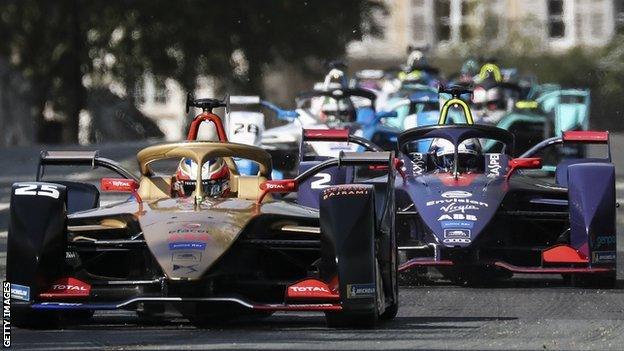Formula E season finale: A season of exciting racing nears conclusion
- Published
- comments

Formula E leader Jean-Eric Vergne is looking to make it back-to-back titles, but there are many permutations before this weekend's climax in New York
Formula E season finale on the BBC |
|---|
Venue: New York City Dates: 13-14 July |
Coverage: You can watch full race coverage from 20:30 BST Saturday, 13 and Sunday 14 July on the BBC Red Button and BBC Sport website and app. |
Formula E truly has it all: crashes, pile-ups, bumper-to-bumper racing, narrow twisty circuits and multiple winners - and that's just in one season that isn't even over yet.
In its five-year existence, it has created its own niche as an environmentally friendly racing series, allowing manufacturers to test and develop new technology for the electric car market.
But it is the racing that appears to be effecting change within motorsport.
While Formula 1 - in its 70th year - battles criticism over the sport being too predictable, with controversial penalties dictating race results and a shortage of close racing, the Formula E season has been packed with thrilling races.
The title race comes to a head this weekend with a double-header in New York City, where Jean-Eric Vergne will hope to convert his commanding 32-point lead at the top of the drivers' standings into his second successive title.
The stage could not be more grand for the season finale, but just what is it that makes Formula E so electrifying?
Narrow, twisty circuits - where team-mates tangle
Jerome d'Ambrosio wins second Formula E race in Morocco
The narrow street circuits of Formula E, with some tricky 90-degree corners, can make overtaking difficult. But the close proximity of the walls and the lack of run-off areas means the margin for error is smaller, and races see frequent yellow flags and safety cars.
The only possible way to get by your rival is to dive for the momentary gaps, or attack on a straight with the extra 25kw of power from the Attack Mode or Fanboost bonuses afforded to the drivers during a race.
In Morocco, Britain's Sam Bird lost his place at the front of the race to the two BMW i Andretti drivers of Antonio Felix da Costa and Alexander Sims, who swapped positions as leaders until an over-excited Sims locked up, showing his team-mate the wall.
Da Costa was out, and fuming, as Jerome d'Ambrosio inherited victory.
Closer racing - where victory can vanish in an instant
Formula E: GB's Sam Bird stripped of Hong Kong victory
Cars getting as close as they can is something fans love, even if it doesn't always work out so successfully for the drivers.
In Formula E there's less 'dirty air' disrupting the flow from the aerodynamics of the car in front - as in F1 - meaning drivers can get closer to their rivals.
Having spent much of the Hong Kong E-Prix locked in battle, Virgin Envision Racing's Sam Bird punctured leader Andre Lotterer's right rear tyre when aiming for an overtake on the final lap.
Bird was given a five-second penalty for what was a "disgusting move", according to Lotterer, stripping him of his win after he had already collected the trophy on the podium and dropping him down to sixth.
Power save - when the battery dies
Formula E: Last-gasp Lucas Di Grassi wins Mexico E-Prix
In previous years, Formula E drivers had to pit for a new car as the batteries did not last for the duration of the race.
But the new 'Gen2' cars can hold on for the 45-minutes-plus-one-lap race duration as long as drivers conserve enough energy to cross the line with some battery life remaining.
In Mexico, the race went to the line. Right to the line.
Mahindra's Pascal Wehrlein was about to take his first series victory after leading much of the race. Audi Sport's Lucas di Grassi spent much of it chasing him down but was unable to find a gap to overtake.
Instead of forcing the issue, he wisely elected to ease the burden on his remaining 2% of battery power by drafting the leader.
What followed was a wonderful edge-of-your-seat moment, Di Grassi swooping around Wehrlein just metres before the line and stealing victory as the 1% battery in the stricken Mahindra ticked down to zero.
Skills really matter...
Formula E: Jean-Eric Vergne wins dramatic Monaco E-Prix
One key difference between Formula E and F1 is that in the electric series the cars run the same chassis and battery. Therefore no one car dominates. Instead, drivers must rely on skill - which explains why, until Monaco, there had been eight races with eight different winners.
Away from racing, Formula E has been hosted by some of the biggest and most impressive cities around the world to share its environmental capabilities and showcase the best electric car technology the manufacturers have to offer.
The cars use road-suitable Michelin tyres which can be recycled, and across race weekends the series promotes the ban of single-use plastics, such as water bottles for spectators and teams.
Just as F1 pushes the boundaries on design, technology, composite materials, and aerodynamic capabilities, Formula E is an avenue for the likes of Jaguar, Audi, BMW and other manufacturers to invest in the future of electric road cars.